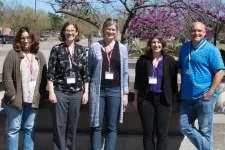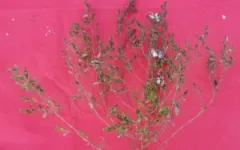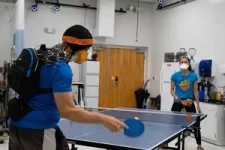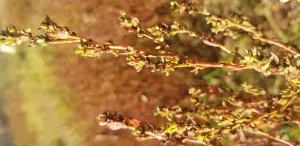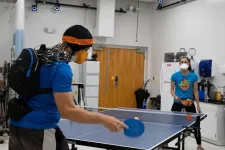(Press-News.org) An interdisciplinary team of researchers at the University of Oklahoma has published a perspective article in the journal Proceedings of the National Academy of Sciences advocating for convergent research that integrates the fields of biogeography and behavioral ecology to more rapidly respond to challenges associated with climate change and biodiversity loss.
While news about climate change fills headlines, the crisis of biodiversity loss has gotten less attention. In their article, the authors contend that “identifying solutions that prevent large-scale extinction requires addressing critical questions about biodiversity dynamics that – despite widespread interest – have been challenging to answer thus far.”
From microorganisms that support soil health, fish that we eat, forests that clean water, to pollination, lumber and medicine, protecting ecosystems and the variety of plants and animals within them is vital to the health of the planet and for humanity to thrive.
“The ways that we respond to climate change also have a big impact on outcomes for biodiversity – which is also a critical part of how the global climate system works,” said article co-author Katharine Marske, Ph.D., assistant professor in the Department of Biology, Dodge Family College of Arts and Sciences.
“Climate change is a major threat to biodiversity, but it’s not the only threat. We also have habitat loss and degradation, direct overharvest of some species and so forth, so it’s also its own unique crisis that needs to be considered on equal footing.”
“Historically in Oklahoma, we can point to cases where we have rapidly removed or changed natural habitats, such as the Dust Bowl,” said co-author Hayler Lanier, Ph.D., assistant curator of mammalogy at the Sam Noble Museum and an assistant professor of biology. “That was a case where we came through and stripped out a lot of the existing natural systems that do things to hold onto the soil and create nutrients, and that was sort of one small example. As we move into the future, we need to think about what sort of world we want to live in, and it is definitely one where we have these sorts of ecosystem services.”
By integrating the fields of biogeography, or the study of how and why biological diversity varies across the Earth, with behavioral ecology, or the study of the evolution of behavior in relation to ecological pressures, the authors argue that scientists will be better able to develop a more comprehensive understanding of how to leverage “existing biodiversity knowledge into predictive frameworks for how biodiversity will respond to environmental change, and where habitat conservation can be most effective.”
“This interdisciplinary connection between behavioral ecologists and scientists who study biogeography has not been linked well to date,” said Laura Stein, Ph.D., article co-author and an assistant professor of biology. “I think in many cases, biogeographers are not thinking about day-to-day activities of animals as much as behavioral ecologists are, and behavioral ecologists are not necessarily considering differences and overlaps in both current and historical ranges and how behaviors have been shaped by past geographic events that might help predict where they will be in the future. And so, by combining these two fields, we can get a much broader picture of what we can do now and what is important for protecting biodiversity into the future.”
The article’s authors have led a pilot of such integrative efforts at the University of Oklahoma, supported by funding from the National Science Foundation.
Co-author Cameron Siler, Ph.D., associate professor of biology and associate curator of herpetology at the Sam Noble Museum, said “We, in the Department of Biology, together with the Sam Noble Museum, carried out a series of cluster hires over the last five years aimed strategically at bringing together integrative researchers with the capacity to think beyond these typically isolated fields, and what’s exciting is this work is a culmination of the success of that early effort to bring scientists like this together at OU.”
Lanier described their work as hopeful. Biodiversity loss and climate change are large, complex and challenging problems to solve. “What we’re trying to do is to harness a lot of information that we already have as scientific and conservation communities and bring it together in new ways to very quickly answer some of these questions.”
Agreeing, Marske added, “The scope of the challenges that society faces require integration, so providing opportunities for this across biology, and amongst all disciplines, increases your chances to bring people together and talk about novel solutions. The more people you can have at that table, the better.”
###
About the Project
“Integrating biogeography and behavioral ecology to rapidly address biodiversity loss,” published April 5, 2023, in the journal Proceedings of the National Academy of Sciences, DOI 10.1073/pnas.2110866120. Marske is the first author, with co-authors Lanier, Siler, Ashlee H. Rowe, and Stein.
About the University of Oklahoma Office of the Vice President for Research and Partnerships
The University of Oklahoma is a leading research university classified by the Carnegie Foundation in the highest tier of research universities in the nation. Faculty, staff, and students at OU are tackling global challenges and accelerating the delivery of practical solutions that impact society in direct and tangible ways through research and creative activities. OU researchers expand foundational knowledge while moving beyond traditional academic boundaries, collaborating across disciplines and globally with other research institutions as well as decision makers and practitioners from industry, government and civil society to create and apply solutions for a better world. Find out more at ou.edu/research.
About the Sam Noble Museum
Designated as the official Oklahoma Museum of Natural History in 1987 by the Oklahoma Legislature, the Sam Noble Museum today houses more than 10 million objects divided between 12 collections, and maintains laboratories, offices, libraries and exhibit space within a 198,000-square-foot facility. The Sam Noble Museum is located on the University of Oklahoma Norman campus at 2401 Chautauqua Ave.
END
The American College of Cardiology will host the annual Advancing the Cardiovascular Care of the Oncology Patient course on April 14-16, 2023, in Washington, DC. The course is intended for all members of the interprofessional care team—including cardiologists, oncologists, pharmacists and nurses—and aims to equip the global cardio-oncology community with the tools they need to improve patient care.
Ana Barac, MD, PhD, FACC, and Bonnie Ky, MD, MSCE, FACC, will serve as co-directors for the course, which ...
PHILADELPHIA—Brain development does not occur uniformly across the brain, but follows a newly identified developmental sequence, according to a new Penn Medicine study. Brain regions that support cognitive, social, and emotional functions appear to remain malleable—or capable of changing, adapting, and remodeling—longer than other brain regions, rendering youth sensitive to socioeconomic environments through adolescence. The findings were published recently in Nature Neuroscience.
Researchers charted how developmental processes unfold across the human brain from the ages of 8 to 23 years old ...
The story of how ancient wolves came to claim a place near the campfire as humanity’s best friend is a familiar tale (even if scientists are still working out some of the specifics). In order to be domesticated, a wild animal must be tamable — capable of living in close proximity to people without exhibiting dangerous aggression or debilitating fear. Taming was the necessary first step in animal domestication, and it is widely known that some animals are easier to tame than others.
But did humans also favor certain wild plants for domestication because they were more easily “tamed”? Research from Washington University in St. ...
Captain of her high school tennis team and a four-year veteran of varsity tennis in college, Amanda Studnicki had been training for this moment for years.
All she had to do now was think small. Like ping pong small.
For weeks, Studnicki, a graduate student at the University of Florida, served and rallied against dozens of players on a table tennis court. Her opponents sported a science-fiction visage, a cap of electrodes streaming off their heads into a backpack as they played against either Studnicki or a ball-serving machine. That cyborg look was vital ...
You’d be hard pressed to find an industry today that doesn’t use data in some capacity. Whether it's health care workers using data to report the rate of flu infections in a certain state, manufacturers using data to better understand average production times, or even a small coffee shop owner flipping through sales data to learn about the previous month’s bestselling latte, data can reveal patterns and offer insights into our everyday behavior.
All of this data plays a critical role in artificial intelligence ...
NEW YORK, NY (April 10, 2023)--Columbia researchers have found that babies born to moms who had mild or asymptomatic COVID during pregnancy are normal, based on results from a comprehensive assessment of brain development.
The findings expand on a smaller study that used maternal reports to assess the development of babies born in New York City during the first wave of the pandemic. That study found no differences in brain development between babies who were exposed to COVID in utero and those who were not exposed.
For the new study, the researchers developed a method of observing infants remotely, ...
DURHAM, N.C. –- Most kids know it’s wrong to yell or hit someone, even if they don’t always keep their hands to themselves. But what about if that someone’s name is Alexa?
A new study from Duke developmental psychologists asked kids just that, as well as how smart and sensitive they thought the smart speaker Alexa was compared to its floor-dwelling cousin Roomba, an autonomous vacuum.
Four- to eleven-year-olds judged Alexa to have more human-like thoughts and emotions than Roomba. But despite the perceived difference in intelligence, kids felt neither the Roomba nor the Alexa deserve to be yelled at or harmed. That feeling dwindled as kids advanced ...
Jane Hooper, Associate Professor, History, received funding for the project: "Global Passages: Creating a Public Database of Slaving Voyages across the Indian Ocean and Asia."
Hooper, along with three other scholars, has received a three-year digital production grant from the National Endowment for the Humanities to support a major expansion of the open access SlaveVoyages website, available online at https://www.slavevoyages.org. The primary investigators will create an Indian Ocean and Asia (IOA) database of voyages that ...
CRISPR-Cas9 is widely used to edit the genome by studying genes of interest and modifying disease-associated genes. However, this process is associated with side effects including unwanted mutations and toxicity. Therefore, a new technology that reduces these side effects is needed to improve its usefulness in industry and medicine. Now, researchers at Kyushu University in southern Japan and Nagoya University School of Medicine in central Japan have developed an optimized genome-editing method that vastly reduces mutations, opening the door to more effective treatment of genetic diseases with fewer unwanted mutations. Their findings were published in Nature Biomedical Engineering.
Genome-editing ...
PITTSBURGH, April 10, 2023 – Black and Hispanic older adults whose annual income is slightly above the federal poverty level are more likely than their white peers to face cost-related barriers to accessing health care and filling medications for chronic conditions, according to new research led by a University of Pittsburgh School of Public Health scientist.
Published today in JAMA Internal Medicine, the analysis links these disparities to a Medicaid “cliff” – an abrupt end ...
